winter
Winter Fun Programs 2022: At the Genesee County Park & Forest
Press Release:
Enjoy the forest in winter and track the secret lives of wild animals on a guided hike! Winter Wonderland Hikes are held at the Interpretive Nature Center at the Genesee County Park & Forest on the following Saturdays:
January 8th from 1:00 to 3:00 p.m.
February 12th from 1:00 to 3:00 p.m.Hikes will go, snow or no snow. Snowshoes may be used, weather permitting, and are available for rent or you may bring your own. Snowshoeing lesson provided, no previous experience needed! Rental is included in the price, $5/person, $15 max/family. Recommended for ages 3 and up! Space is limited! Pre-registration is required, call 585- 344-1122! Masks must be worn whenever unable to maintain 6 feet of social distance. Join us for Winter Fun Night Hikes from 7:00 to 9:00 pm on the following Saturdays: January 8th Meet at the Interpretive Nature Center February 12th Meet at Pavilion A.
Enjoy the tranquil beauty of the forest at night! Park guides lead you on a night hike for ages 18 and over. Snowshoes may be used, weather permitting, and are available for rent or you may bring your own. Snowshoeing lesson provided, no previous experience needed! Rental is included in the price, $5/person, $15 max/family. Space is limited! Pre-registration is required, call 585-344-1122! Masks must be worn whenever unable to maintain 6 feet of social distance Make a memory this winter with your own Private Group Snowshoe Hike! A Naturalist guides your group through peaceful woodland trails and open meadows. Listen to winter’s quiet beauty and find signs of wildlife in this 431- acre park. Private hikes are available on Saturdays in January and February from 10:00 am – 12:00 pm by reservation only at the Interpretive Nature Center. No previous experience is needed; snowshoes provided or bring your own.
Rental is included in the price. Limit group size of 10 people. $5/person, minimum group fee is $50. Call 585-344-1122 to book your own adventure! Snowshoe Rentals are available at the Genesee County Park & Forest Interpretive Center 10:00 am – 3:00 pm on
Thursdays and Fridays, 12:00 pm – 3:00 pm on Saturdays and Sundays December through March, weather permitting.
Snowshoes must be used in the park. Fee is $5/pair and all proceeds go to ACORNS, the nonprofit organization that supports the parks!Call (585) 344-1122 to register. For more information visit our website at
http://www.co.genesee.ny.us/departments/parks/
Afternoon of snowmen building
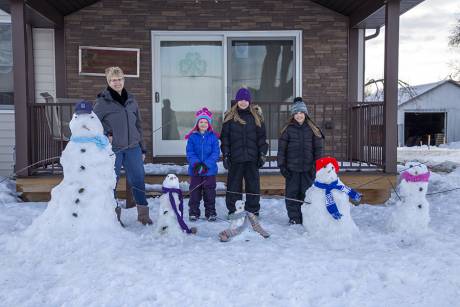
The George family siblings worked on building some snowmen with their grandmother yesterday afternoon before the warmer temperatures came in today. It was good packing snow and they wanted to take advantage of having some outdoor fun while we still had some snow.
Snow memories made today
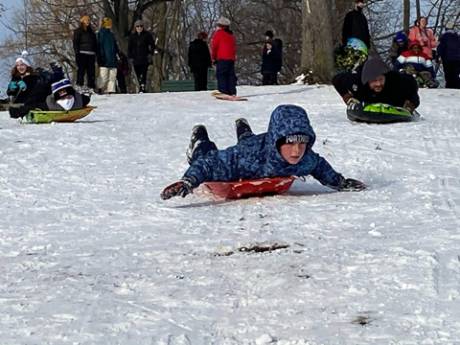
All day long sledders of all ages enjoyed being out in Centennial Park. The winter fun and tradition continues.
Photos by Jim Burns.
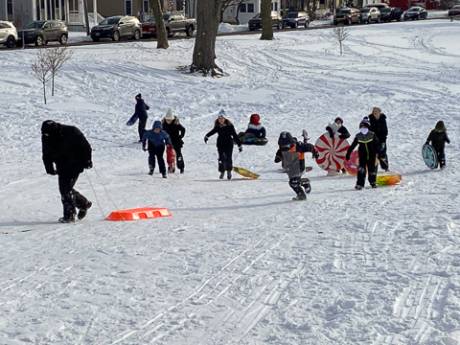

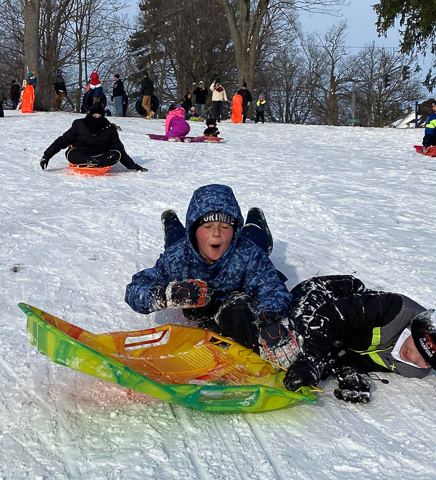
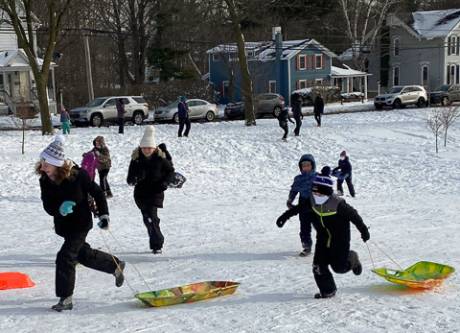
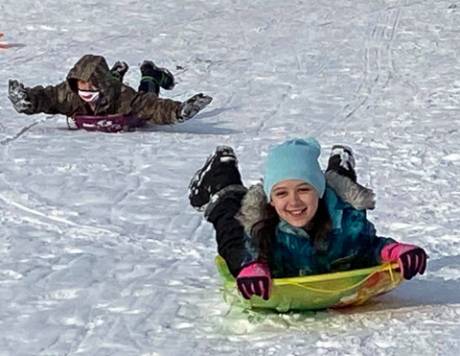
Sponsored Post: Mark Lewis Agency/State Farm - Winter driving tips
Prepare Your Vehicle for Winter: The best time to get ready for winter is before the first storm of the season. Some items to check and talk to your mechanic about include:
- Test the battery strength.
- Inspect the exhaust system and the air, fuel, and emission filters.
- Check the cooling system, windshield wiper and antifreeze fluid levels, and change the oil.
- Make sure hoses and fan belts and all components are working properly.
- Consider changing the spark plugs.
- Check the tire pressure, tread life and consider installing winter tires.
- Locate the spare tire, jack, and ice scrapper.
- Inspect your wiper blades to make sure they're functional and in good condition.
Some Simple Winter Driving Tips: Winter driving has its own set of challenges from the moment you start your vehicle. Here are some useful winter driving suggestions:
- Never warm up your vehicle in a closed garage. This could lead to carbon monoxide problems.
- Keep your gas tank at least half full to prevent gas line freeze-up.
- Make sure your exhaust pipe is not clogged with mud or snow.
- Don't use cruise control on icy roads.
- Allow more time for braking when visibility is poor.
- Stay calm if you start to skid.
Commercial vehicle drivers should exhibit caution when driving in winter conditions. If your vehicle is large, like a truck, it needs more time to stop in ideal conditions, so snow and icy conditions magnify the challenge. Take care to continue safe practices when sharing the road in winter conditions.
Carry a Winter Driving Kit: Winter weather could leave you stuck in the snow, but the following items in your winter driving kit might help you get back on the road and on your way:
- Small folding shovel
- Tow and tire chains
- Basic tool kit
- Bag of road salt or cat litter
- Flares, battery powered flashlights and extra batteries
- Extra windshield wiper fluid and antifreeze
- Jumper cables to start your car if your battery dies
Pack a Winter Survival Kit: In case you're marooned in your car, truck or SUV, you might want to keep a small winter survival kit on hand. Some useful items include:
- A first-aid kit
- Cell phone charger
- Ice scraper and brush
- Blankets, warm clothing and other cold weather gear to protect against hypothermia
- Drinking water, and high-energy, nonperishable foods
Snow Safety Tips if You Become Stranded in the Winter: Few people like driving through a snow storm, and most heed warnings to stay off the roads when a storm is bearing down. But even the best-prepared and expert drivers can get stuck. If it happens to you, here are some important reminders:
Be prepared. While the best first step is prevention, some storms come on quickly. If you do get stranded, keeping a few essentials, noted above, in your car can help keep you comfortable while you wait.
Stay inside. If possible, pull off the highway and turn your hazard lights on or tie something bright to your car’s antenna to signal that you need help. Then wait inside your car until help arrives to avoid exposure to frostbite and prevent hypothermia.
Call 9-1-1. If you have a charged phone and reception, call for help and describe your location as best you can.
Clear the tailpipe. Make sure there’s no snow covering your tailpipe in order to prevent carbon monoxide buildup inside the car. Check the tailpipe periodically to ensure that fresh snow isn’t blocking it, always watching for oncoming traffic before exiting your vehicle.
Keep moving. Staying active inside your car will help you keep warm. Clap your hands and tap your toes to keep your circulation moving and prevent frostbite but avoid overexertion and sweating.
Drink fluids. Dehydration can make you more susceptible to the effects of cold. If there’s no drinking water inside your car, melt some snow inside a bag or other makeshift cup to stay hydrated.
Conserve your vehicle's battery. Use lights, heat, and radio sparingly.
Run your engine. Provided you have enough gas in your tank, run the engine for about 10 minutes every hour to keep the car warm. Turn on interior lights when your engine is on so you can be seen inside your car. Open a downwind window slightly for ventilation and clear snow from the exhaust pipe to prevent carbon monoxide poisoning.
Don’t overexert yourself. Cold weather puts your heart under added stress. If you’re not used to exercise, shoveling snow or pushing a car could put you at risk of a heart attack.
Stay safe and warm this winter by learning more about preparation for and recovery from winter storms with State Farm®
Sponsored Post: Winter driving tips - State Farm - Mark Lewis
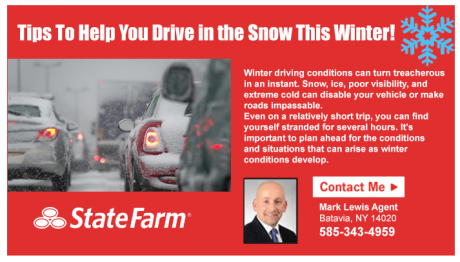
Prepare Your Vehicle for Winter: The best time to get ready for winter is before the first storm of the season. Some items to check and talk to your mechanic about include:
- Test the battery strength.
- Inspect the exhaust system and the air, fuel, and emission filters.
- Check the cooling system, windshield wiper and antifreeze fluid levels, and change the oil.
- Make sure hoses and fan belts and all components are working properly.
- Consider changing the spark plugs.
- Check the tire pressure, tread life and consider installing winter tires.
- Locate the spare tire, jack, and ice scrapper.
- Inspect your wiper blades to make sure they're functional and in good condition.
Some Simple Winter Driving Tips: Winter driving has its own set of challenges from the moment you start your vehicle. Here are some useful winter driving suggestions:
- Never warm up your vehicle in a closed garage. This could lead to carbon monoxide problems.
- Keep your gas tank at least half full to prevent gas line freeze-up.
- Make sure your exhaust pipe is not clogged with mud or snow.
- Don't use cruise control on icy roads.
- Allow more time for braking when visibility is poor.
- Stay calm if you start to skid.
Commercial vehicle drivers should exhibit caution when driving in winter conditions. If your vehicle is large, like a truck, it needs more time to stop in ideal conditions, so snow and icy conditions magnify the challenge. Take care to continue safe practices when sharing the road in winter conditions.
Carry a Winter Driving Kit: Winter weather could leave you stuck in the snow, but the following items in your winter driving kit might help you get back on the road and on your way:
- Small folding shovel
- Tow and tire chains
- Basic tool kit
- Bag of road salt or cat litter
- Flares, battery powered flashlights and extra batteries
- Extra windshield wiper fluid and antifreeze
- Jumper cables to start your car if your battery dies
Pack a Winter Survival Kit: In case you're marooned in your car, truck or SUV, you might want to keep a small winter survival kit on hand. Some useful items include:
- A first-aid kit
- Cell phone charger
- Ice scraper and brush
- Blankets, warm clothing and other cold weather gear to protect against hypothermia
- Drinking water, and high-energy, nonperishable foods
Snow Safety Tips if You Become Stranded in the Winter: Few people like driving through a snow storm, and most heed warnings to stay off the roads when a storm is bearing down. But even the best-prepared and expert drivers can get stuck. If it happens to you, here are some important reminders:
Be prepared. While the best first step is prevention, some storms come on quickly. If you do get stranded, keeping a few essentials, noted above, in your car can help keep you comfortable while you wait.
Stay inside. If possible, pull off the highway and turn your hazard lights on or tie something bright to your car’s antenna to signal that you need help. Then wait inside your car until help arrives to avoid exposure to frostbite and prevent hypothermia.
Call 9-1-1. If you have a charged phone and reception, call for help and describe your location as best you can.
Clear the tailpipe. Make sure there’s no snow covering your tailpipe in order to prevent carbon monoxide buildup inside the car. Check the tailpipe periodically to ensure that fresh snow isn’t blocking it, always watching for oncoming traffic before exiting your vehicle.
Keep moving. Staying active inside your car will help you keep warm. Clap your hands and tap your toes to keep your circulation moving and prevent frostbite but avoid overexertion and sweating.
Drink fluids. Dehydration can make you more susceptible to the effects of cold. If there’s no drinking water inside your car, melt some snow inside a bag or other makeshift cup to stay hydrated.
Conserve your vehicle's battery. Use lights, heat, and radio sparingly.
Run your engine. Provided you have enough gas in your tank, run the engine for about 10 minutes every hour to keep the car warm. Turn on interior lights when your engine is on so you can be seen inside your car. Open a downwind window slightly for ventilation and clear snow from the exhaust pipe to prevent carbon monoxide poisoning.
Don’t overexert yourself. Cold weather puts your heart under added stress. If you’re not used to exercise, shoveling snow or pushing a car could put you at risk of a heart attack.
Stay safe and warm this winter by learning more about preparation for and recovery from winter storms with State Farm®
Sponsored Post: State Farm - Mark Lewis Agency - Get your home winter ready

Be energy efficient
Since your heating system will probably be running constantly throughout the winter, remember to change out your HVAC filters every month. Inspect the insulation in your attic and crawl space. Warm air rises and leaves the house through the roof, so you should focus on insulation in your ceilings. Seal areas around recessed lights, the attic hatch, and plumbing vents that may be allowing warm air from the living space below to enter the attic. Proper attic ventilation, adequate attic insulation, and a tight air barrier between the attic and the interior of the house will work together to prevent ice dams.
If you don't have double-paned windows, remove the screens and install storm windows to ensure that the heat stays in and the cold stays out. If you're on a tight budget, pick up an inexpensive plastic-film sheet kit from your local hardware store. These will only last one season, but they do help with energy efficiency and are able to halt the cold flow of winter drafts. If you have a fireplace, burning firewood is another way to save energy costs. When you use the fireplace, reduce heat loss by opening dampers in the bottom of the firebox (if provided) or open the nearest window slightly -- about an inch -- and close doors leading into the room. That will prevent the fire from drawing warm air out of the rest of the house and replacing it with cold air. And remember to store your firewood in a dry place at least 30 feet from your home to avoid a fire hazard.
Protect your pipes
Pipes located in attics, crawl spaces, basements, and near outer walls can be susceptible to freezing in extreme temperatures. When the forecast calls for unusually cold temperatures, let water drip from hot and cold faucets overnight. Also try keeping cabinet doors open to allow warm air to circulate in places like below sinks. If you open the cabinet doors, be sure to remove anything inside the cabinets that may pose a safety to hazard to children, such as household cleaners. For exposed pipes in your attic, basement or crawl spaces, add extra insulation around them. View the tips to avoid frozen pipes for more information.
Be ready for an emergency
Blackouts and snow-ins can occur during winter months, so take a moment to prepare yourself and your family for such emergencies. Having the following items ready will help you make it through safely.
- Flashlights
- Bottled water
- Nonperishable food items
- Blankets
- Phone numbers for your utility companies
- Battery backup to protect your computer and other important electronic equipment
- First-aid kit
Decorate safely
'Tis the season to be festive, but remember to stay safe with your holiday decorations. Inspect the wires of your light display before switching them on—they may be frayed and present an electrical fire hazard. Same goes for the Christmas tree inside -- always check the light strands for any sign of wear and tear from being in storage. If you have a real Christmas tree, keep it watered, since dry trees catch fire easier. Check with your local municipality for instructions on how to dispose of the tree once the new year arrives.
Don't forget yard care
Even with the cold weather conditions, your yard still needs to be maintained. Make sure tree and shrub branches are well away from the house and windows. Icy conditions can cause branches to break and damage your home. Walk around your home and survey the roof to see if any ice dams have formed; call a contractor if you suspect this is the case. As you walk around your house, check the foundation for small cracks or openings where mice or other pests can tunnel in. Winter is when they seek the warmth of your house, so seal up any possible entrances. While you're outside, clear snow off gas meters and away from basement windows and your dryer exhaust vent.
GCC's Toriseva named 2015 award winner in contest on 'Winter in Variations' poetry, photography
Press release:
Finding beauty in a Western New York winter is not always an easy thing to do. For Genesee Community College's JoNelle Toriseva, director of English, Communications and Media Arts and assistant professor of English, channeling the sometimes treacherous outside conditions into works of poetry and photography recently earned her recognition from the public charity Writers Rising Up.
It named her the Winter in Variations: Bill Holm Witness Poetry Contest Winner, Writers Rising Up to Defend Place, Natural Habitat, Wetlands for 2015.
The contest required a submission of six original, unpublished poems about witnessing some everyday occurrence in winter and additional photography, which is not Toriseva's strong suit.
"When I received the email that I had won, I was surprised," Toriseva said. "I was also very happy; however, they told me that I needed to take pictures of what I considered winter and I am more apt to be the person who gets a photograph of someone's feet or the back of their head, so I sought help."
Toriseva called on Joseph "Joe Z" Ziolkowski, GCC instructor of Photography, who guided her through taking shots outdoors with surroundings that included freshly fallen snow. The photographs, candid's of crab apple trees on the GCC Batavia Campus and a few of brush in the Bergen Swamp at dusk, were accepted by the organization as part of her winning submission.
Writers Rising Up is a public charity that focuses on nature education and writing through the literary arts at community events, contests, workshops, literary performances interpretive installations and publications. The organization hosts numerous poetry and literary contests, competitions and events for writers to submit and perform literary interpretations related to place, natural habitat and wetlands.
Toriseva's award-winning work included original poems titled "Perceive," "Dart," "Talking in Snow: A Short History of Sound," "The Benchmark of Winter," "Crossing" and "Winter, December #73," and can be viewed online at http://www.writersrisingup.org/all-contests/essay-winners/j-r-toriseva-bill-holm-winner.
A native of rural Minnesota, the home state of the award-honoree Bill Holm, Toriseva grew up an admirer of the author of nine books of both poetry and essays.
"I have known about Bill Holm for a long time. He is a staunch supporter of nature, which greatly interests me," Toriseva explained. "The fact that the Writer's Rising Up organization and the award raise awareness about wetlands and natural habitat makes this very special to me."
For further information about Writer's Rising Up and to view Toriseva's award-winning work, including her photography, visit the organization's Web site: http://www.writersrisingup.org/.
Conversations with Calliope- Deep Freeze
(Winter Post)
JOE: Good morning Calliope.
CALLIOPE: Good morning Joe. I trust you had a good week at GO ART!
JOE: I did. I was quite busy working on revisions to their website. I had to dust off my Dreamweaver skills.
CALLIOPE: Are you making progress?
JOE: I am but it's nice to have a break today.
CALLIOPE: You haven't said anything about your writing lately.
JOE: I finished my review of Marital Property and have my three readers at work.
CALLIOPE: Then what?
JOE: They are proofing as well as commenting on the manuscript. After I get their input I will decide how to proceed.
CALLIOPE: Are you considering a run at traditional publishing this time?
JOE: I am considering it. We shall see.
CALLIOPE: What are you doing while you wait for their input?
JOE: Today I will continuing work on another project. Talk with you Monday.
Conversations with Calliope- Facing Winter
var gaJsHost = (("https:" == document.location.protocol) ? "https://ssl." : "http://www.");
document.write(unescape("%3Cscript src='" + gaJsHost + "google-analytics.com/ga.js' type='text/javascript'%3E%3C/script%3E"));
(The Rockies)
JOE: Good morning Calliope.
CALLIOPE: Good morning Joe. How are you today?
JOE: Bracing for winter.
CALLIOPE: Tell me more.
JOE: Just as I am reviewing late Fall and Winter scenes from Marital Property, the first winter storm arrived here in Western New York.
CALLIOPE: A double whammy.
JOE: Indeed. My real and fantasy worlds are both preparing for a long siege of blustery weather.
CALLIOPE: Does that depress you?
JOE: I must admit I prefer sitting in the back yard in shirt sleeves.
CALLIOPE: Any advantages to winter?
JOE: Overall I do less traveling and become more focused on indoor activities such as writing.
CALLIOPE: Not a bad thing.
JOE: No, it isn't. Sometimes I wonder if I would appreciate summer if I did not have winter for contrast.
CALLIOPE: You might take it for granted.
JOE: Perhaps. But I'll use whatever incentives I can find. Talk with you tomorrow.
Snow advisory through this evening
We could see as much as five inches pile up by dinner time tonight. The National Weather Service out of Buffalo has issued a lake effect snow advisory for the region until 6 o'clock this evening. From the advisory:
Bands of lake effect snow will persist through the day. New accumulations in the most persistent bands will be in the 3 to 5 inch range. Brisk west to northwest winds will also lead to areas of blowing snow and poor visibilities.
In lake effect snow, the weather can vary from locally heavy snow in narrow bands to clear skies just a few miles away. If you will be travelling across the region be prepared for rapid changes in road and visibility conditions.
There's not much to see out on the radar so far.
However, things look a little greasy out on the Thruway.
Wind warning downgraded, flood warning extended through Friday
We may be in the clear for any further threats of severe wind damage for Genesee County, but Batavia is still under watch for a flooding of Tonawanda Creek. This is a clip of the roiling creek that looked set to swell up and over its banks earlier this afternoon out back of the county court house.
From the National Weather Service:
The flood warning continues for the Tonawanda Creek at Batavia until Friday afternoon. At 12:00 p.m. Thursday, the stage was 9.5 feet and rising. Minor flooding is occurring and minor flooding is forecast. Flood stage is 9.0 feet. Forecast: The river will continue to rise and crest near 9.8 feet this evening. Impact: At 10.0 feet, moderate flood, minor to moderate flooding along the entire reach from Batavia to Tonawanda, most focused in Alabama swamps, rapids and northern Clarence and Amherst, and also in the city of Batavia, west of Main Street.
On the wind advisory:
Southwest winds of 20 to 35 mph this afternoon could gust over 45 mph. The greatest chance for the higher gusts will be found over elevated terrain. These winds will become more westerly during the course of this afternoon before diminishing late in the day.
While the threat of widespread wind damage has diminished, shallow rooted trees, namely pines, will still be vulnerable in this event as their shallow root system has become less stable with the thawing of the previously frozen ground. Scattered power outages will still be possible from downed tree limbs and power lines.
Road conditions deteriorate quickly in Genesee County and environs
Roads around Genesee County are getting ever worse throughout the day today. Snow and rain have added to the already bloated mix of melted ice and snow from yesterday. Some roads are barely navigable at this time. Add to that the winds that are bringing down power lines across the region, and you've got a messy situation out there.
In the past half hour, we've heard of two reports of downed wires over the scanner.
Poles and wires have come down on Molasses Hill Road near Chaddock Road in Alexander. Another pole along with wires are blocking a roadway in Attica. We haven't yet got the report on that exact location, but crews are out trying to get things cleaned up as quickly as possible.
Conditions are even worse in Wyoming County, where the winds are whipping even more fiercely. Dan Fischer reports that the office of emergency management there has put out a general travel advisory for motorists. It reads: "Caution should be used when traveling in Wyoming Co. due to damage from high winds including downed utility poles and power lines. Be prepared to seek alternate routes as some roads have been closed due to blockage."
You can find out more on area closings by visiting the WBTA Web site.
News roundup: Two school closures and power outages in the area
Attica and Wyoming central schools are closed this morning as a result of the fierce weather, according to WBTA's Dan Fischer.
We've also got power outages in the area: some 73 folks are without electricity in and around Alexander, and another 65 are in the dark in Darien. Wires have come down on Dewey Road in the town of Batavia. No outages yet reported in that region.
All around nasty weather throughout the day throughout the region
We're in for an ugly cocktail of dangerous weather today. Right now, Batavia is under three separate warnings, issued by the National Weather Service. Ice floes and warm temperatures look to flood the Tonwanda Creek. Winds of sustained gusts at 40 mph are whipping up to 70 mph at times. And, just for good measure, we've got a snow storm.
On the flood:
The flood warning continues for the Tonawanda Creek at Batavia from this morning to tonight. At 5:00 a.m. Thursday the stage was 72 feet and rising. Minor flooding is forecast. Flood stage is 9.0 feet... The river is expected to rise above flood stage late this morning and crest near 9.2 feet this afternoon.... At the 9.0 flood stage: Flood protection at Chestnut Street Bridge begins to be toppd. There is also flooding in Kibbe Park area of Batavia.
On the wind:
Deep low pressure will pass by to our north today. Southwest winds of 30 to 40 mph will gust as high as 70 mph during the day today. The powerful winds will become more westerly this afternoon then will gradually diminish tonight.
Shallow rooted trees, namely pines, will be especially vulnerable in this event as their shallow root system has become less stable with the thawing of the previously frozen ground. The added weight from several inches of wind blown wet snow will likely increase the potential for some downed tree limbs and power lines.
On the snow:
A winter weather advisory remains in effect until 6:00 p.m. this afternoon.
Cold, moist air filtering in behind a departing low will bring 2 to 4 inches of snow to the area today. Another 1 to 3 inches is expected tonight. Strong winds will add to the problems and generate very poor visibility at times and make it difficult to keep roadways clear.
Things do not look pretty out at the Thruway right now. Please be safe.
Snowman stands proud on Main Street Batavia
We spied this snowman built up out front of T-shirts Etc. on Main Street Batavia earlier today and thought to take a photo.
Let's call this a challenge to all Main Street merchants. Bring out your snowmen!
Snow mounds in Batavia growing tall
Driving along Main Street this afternoon, it dawned on me that I couldn't see some of the shopping plazas I normally pass by on my drive between Clinton Street Road and Center Street. Well, they were still there, only they were blocked by the mounds of snow like walls stacked high at the front of the parking lots. Down near Masse Place, in fact, you can't see any of the shops from the street. This is all you're going to see:
So this got me wondering: Where's the tallest snow mound in Batavia? This one looks like it could fit the bill, but I haven't been everywhere.
Poll: Predicting winter's end...
Punxsutawney Phil climbed out of his burrow on Gobbler's Knob yesterday to find his shadow and thus predict for us another six weeks of winter. From the Washington Post:
According to legend, if a hibernating animal wakes up and casts a shadow on Feb. 2, winter will last six more weeks. If there is no shadow, spring will supposedly come early.
Early American farmers relied on groundhogs, though there is no scientific evidence that the animal has any weather-predicting skills.
What do you think?
Another six weeks of winter...?( polls)
Walking around the city during the storm
After getting caught in the snow four times during our last blizzard, I figured driving was not an option. Who in their right mind is going to drive around in this?
Apparently a lot of people are doing just that as Main St. had its usual mid-day traffic and was cleaned up for the most part.
Well I decided to get all bundled up and go for a walk. Dumb idea.
I took a trip around my part of the city, walking around two different blocks, and it was brutal. The weather is 32-degrees right now, so it wasn't the cold that was the problem. It was the snow coming down in such a burdensome manner.
I'm guessing that if you get outside of the city and are driving on Rt. 63 or 19, you are in for a lot of whiteout conditions as there is a slight wind in the city, which means when you get out you are in trouble.
This isn't that light snow that is nice to see once in a while. This is the big flake, heavy, pain in the butt type of snow. I am so happy that my neighbor has a big snow plow and is a good guy or I would be in trouble today. I still can't lift heavy stuff after the carpal tunnel surgeries over the summer and I have a feeling that it would kill me to have to clear that stuff out on my own.
So I noticed a few things on my walk. First is that moving during the winter sucks. I found a guy moving in on Montclair Ave. and let's just say these aren't the ideal conditions.
In fact, he tried to move the moving truck so that the plow could get down the street, and the battery had died. He found somebody and was getting a jump as I decided to head towards Main St.
I understand the sidewalks on the side streets being bad because people are at work. I just walked down the road. But I watched the mail carrier walking through big piles of snow and struggling just to get to people's mail boxes.
And then I got to Main St. and the sidewalks were just as bad.
I made a left and walked towards Burger King and Arby's - which were both pretty slow for a mid-afternoon on a work day - and the sidewalks were clear in some places and not even touched in others. I thought the city owned some big machine that is supposed to drive around and clear of sidewalks?
How about getting that thing out on Main St.
I could hear the speaker at Ken Barrett's calling for service, but none of the cars were cleared off and nobody was shopping for a car. I get it. There is no way to get a feel for a vehicle when you can't drive faster than like 15 miles per hour.
I really was surprised at the amount of people out there driving because it is nasty out and probably will be for the rest of the afternoon.
I saw a few people out shoveling and plowing driveways, but most of those that work during the day looked like they went in because driveways were packed all over the place.
As I was walking down Oak St., I saw a guy riding a bicycle down the road. He wasn't moving very fast and I can't imagine it was a pleasurable trip. I've never understood those that ride bikes when the weather is like this.
Finally I got home. What would usually be a 45 minute trip around a couple blocks took nearly and hour and half, but I did stop and talk to a few folks out there clearing their driveways and walking places.
The most common complaint I heard was the lack of cleared out sidewalks. If anybody knows about how the city handles sidewalks, I'd love to hear it.
I finally got home and was able to sit down at my computer, after a change of clothing because I looked like a snowman.

